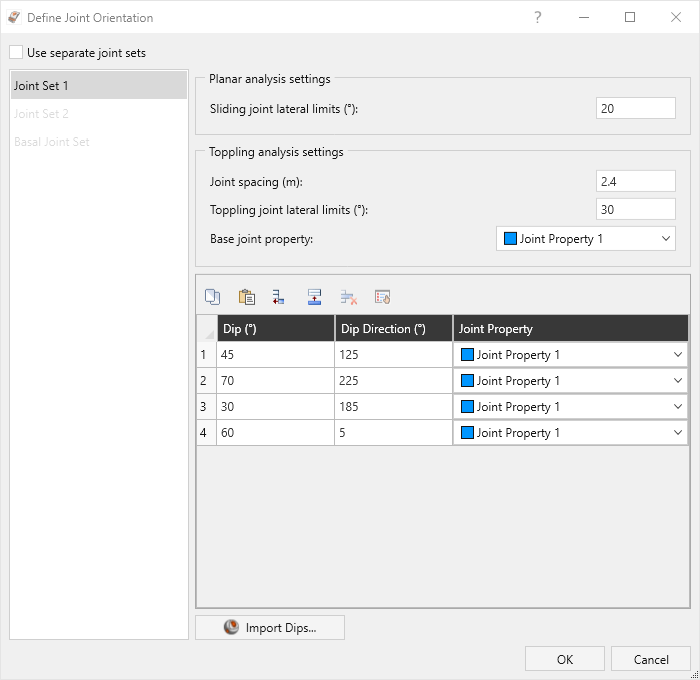Joint Orientations Overview
Joint plane orientations must intersect the slope planes in a kinematically admissible manner, such that a block is formed which is capable of being removed from the slope.
RocSlope2 automatically performs a Combination Analysis and considers all possible combinations of joints which can form a block. The combinations of joints considered can be from a single list of joint data, or two sets which can be enabled using the Use Joint Sets option.
If you are using the Basal Joint option for Wedge Analysis, an additional third joint plane can be defined.
To define the Joint Orientations:
- Select Home > Joints > Orientations
- The Define Joint Orientation dialog will open. The Joint Orientation dialog consists of the following settings and options:
- Planar Analysis Settings
- Toppling Analysis Settings
- A table containing Dip, Dip Direction and the selected Joint Property

For a Probabilistic Analysis, it is possible to define statistical variability of the joint plane orientations. See the Joint Orientation Statistics topic for more information.
Joint Sets
By default, RocSlope2 considers a single joint set for block formation. The Use Separate Joint Sets option in the Define Joint Orientation dialog allows users to analyze multiple sets of joints with one another.
Single Joint Set
For Wedge blocks, combinations of any two joints from this set are used to form blocks.
For Planar blocks, all possible joints within the Sliding Lateral Limits are considered. Similarly, for Toppling blocks, all possible joints within the Toppling Lateral Limits are considered.
Separate Joint Sets
To evaluate possible joint pairings between separate joint sets, check the Use Separate Joint Sets checkbox. This will enable a second joint set to be edited. Additionally, when Block Shape is set to Basal Joint, a third joint set (Basal Joint Set) will be enabled for editing.
For Wedge blocks, combinations of one joint from Set 1 and one joint from Set 2 are considered. For a Basal Joint analysis, a basal joint from the Basal Joint Set will also be considered in the block formation.
For Planar and Toppling analyses, all joints from both sets which fall within their respective lateral limits are considered. See the Planar and Toppling Analysis Settings topics for more information on lateral limits.